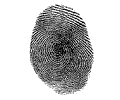Full-colour fingerprints could bring useful additional biometric data to future law enforcement.
New technology developed by a University of Toronto-led team of international researchers uses elastic photonic crystals to capture data-rich fingerprints in multiple colours. The team's innovation could have many other applications.
“You can elastically deform these crystals and produce different colours,” said André Arsenault, a PhD candidate in the laboratory of Geoffrey Ozin, a University Professor in the Department of Chemistry and a Canada Research Chair in materials chemistry.
Photonic crystals use micrometer-scale spherical particles of silica that self-assemble into neat layers, creating what’s known as an opal. After filling the space between the spheres with silicon, acid etching removes the silica balls, leaving an ordered sponge of air bubbles in silicon known as an inverse opal. This photonic crystal material traps light and can produce colour based on how an electromagnetic wave interacts with the structure.
In the study, the team injected an elastic compound between the spheres, which were then etched away, leaving an orderly and compressible elastic foam that can be transferred onto virtually any surface, such as glass, metal or plastic. The material changes colour based on how far the spheres are separated.

“The material we have is very, very thin,” Arsenault says. “We can coat it onto any surface we want.” If the foam is compressed, it alters the lattice dimensions, changing the wavelength of light that it produces. The team demonstrated the fingerprint application, using Arsenault’s finger, and produced both still images and a video of the process, which captures detailed information about pressure patterns and surface ridges that may not be visible to the naked eye.
Unlike some traditional fingerprint scans, the new method could no be fooled by a rubber replica fingerprint. “If you press the rubber replica into the material, the pressure impressions that you get are very different,” Arsenault says. “The lines are much sharper, because the material is less soft. From the standpoint of biometrics, this could provide better security.”
Arsenault says the technology could be used not only for colour fingerprints, but also in sensors for air-bag release mechanisms in cars, strain and torque sensors on support beams of high-rise buildings and in laser sources. The study was funded by the Natural Sciences and Engineering Research Council of Canada, the University of Toronto, EC NoE Phoremost and Deutsche Forschungsgemeinschaft.










New IET report examines grid transmission costs
I imagine the cables are heavily optimised but you do wonder whether the heat dissipation can be improved. Perhaps some lateral fins? Fitting them...